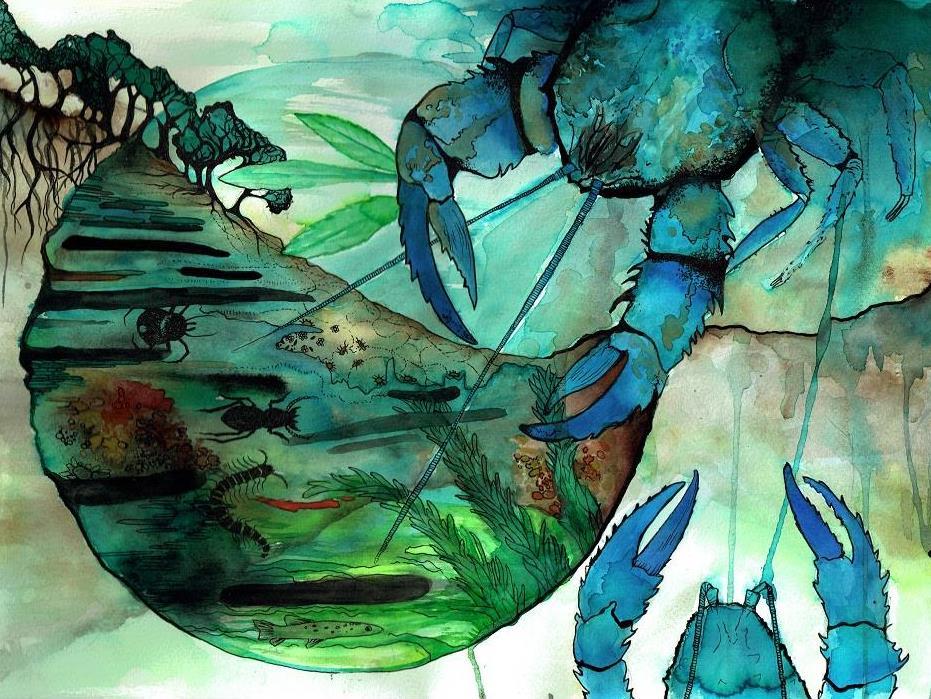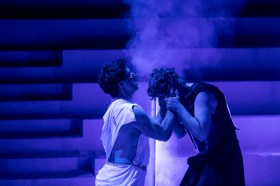Image: Tarkine in Motion (detail) by Aviva Reed, via Tasmanian Arts Guide.
One of the first forums I attended in my role as Member for Bass was with the UTas Institute for Social Change. Professors, theorists and consultants were invited from distant lands to discuss the cultural industries with special reference to MONA.
The program used a series of seminars to break down the relationship between MONA and the city, MONA and the State to discern whether there was a further opportunity to harness the catalytic effect of the museum’s success.
The theorists were chosen from the disciplines of urban and cultural planning, cultural studies, and cultural policy. They were also chosen because they had no prior connection to MONA and had not visited Tasmania since MONA had been built. The hope was that this method would generate a debate with a fresh perspective which could be used to further inform policy and ideas.
A debate turned to Tasmania as a producer of art and the opportunity available to our community to create policy and funding around Tasmanian artists. The value of MONA to Tasmanian artists is as a facilitator for a greater recognition and to foster greater participation. Being known for a famous art gallery and museum could naturally extend into being known as a place for artists and art production.
A cultural policy consultant spoke of a requirement for Tasmanians to redefine themselves in light of the global attention which we have received since the museum had opened and again warned that without a healthy arts ecology, opportunity for building wider capacity and accessibility was being diminished. He spoke of the ability for the all levels of government in Tasmania to start taking risks in the art sector as an adjunct to MONA and an opportunity for increased participation.
Since that time we have witnessed the closure of Tasmanian Regional Arts and seen a cementing of festivals as the purveyor of arts in Tasmania. MONA has gone from strength to strength with its now famous collection, buildings and festivals. MONA has been able to cement the success of its winter festival, a first for Tasmania, where we once shied away from the cold winter, we now embraced the opportunity.
There are valuable art prizes, there are many artists whose sole income is their practice, but it’s the community artists who I feel are suffering. The community members who find connection and community through the shared art experience. They might not be noteworthy when compared to the incredible influence a collection like MONA can have on an island but they do speak to the need for our regional and rural communities to have human connections in an increasingly detached world.
Read: What’s next for the arts in the island state
We know visitors to Tasmania are drawn to the island because of diverse natural beauty and some curators have been able to seize the opportunity which the nexus between natural places and art presents.
Certainly the Bob Brown Foundation has found enormous success with the Tarkine in Motion series, encouraging artists into takayna/the Tarkine to immerse themselves in the landscape and then draw on the experience in their art practice. The expression of place can be felt in the work and brings to the audience the underlying message that this place of rare beauty and ancient Aboriginal heritage continues to be threatened by industrialised logging and mining practices.
Cradle Mountain has a newly refurbished exhibition space, where Consultant, Kylie Eastley, has been able to build on history and place to provide other options to walking, wining and dining into the mountain resort experience.
Arts Tas has become the gatekeeper for state funding now that Tas Regional Arts has folded and there is a push by the Arts Minister for arts organisations only to be considered sustainable and viable when benchmarked against commercial business practices.
We know that not all arts organisations will be commercially viable and do not believe that is a measure for success for a myriad of reasons.
When Federal Minister, Simon Birmingham, cut funding to Vocational Education and Training courses he considered “lifestyle choices” he severed one of the segments in the arts ecosystem which is so important.
57 creative courses were cut from the funding model in a clear indication that the LNP learned nothing from the Brandis Australia Council funding debacle and continues to fail to understand the personal enrichment the arts can bring to a community.
Our Vibrant Public Spaces policy initiative aims to draw on the success of artists who frame their practice in wild places with positive procurement practices around government advertising and extending artists in residence programs.
We will ensure adequate funding to regional arts through Arts Tas and audit the spread of the regional funding spread to ensure that no region misses out.
We will provide a modest funding pool to the Department of Education to ensure teachers are able to purchase additional equipment at their own discretion but not out of their own pockets.
Our policy will mandate for a 1% expenditure on all new significant infrastructure developments, ensuring that local artists have opportunity to apply to have works included.
In my beautiful home town of Launceston, we would trial a project for temporary art installations for up to a month.
Launceston has an urban rejuvenation project underway, and those infrastructure works would benefit from an engagement from our arts community. This engagement could bring originality, flavour and renewal to a city undergoing transition, which aims to be one of Australia’s premier regions.
There is no doubt that Tasmania has been transformed by the MONA effect. The recent marriage equality survey results found the once deeply conservative state was one of the highest percentage states in the ‘yes’ camp. We owe much to the local art community who primed the state toward more progressive values and to David Walsh for bringing it home.






